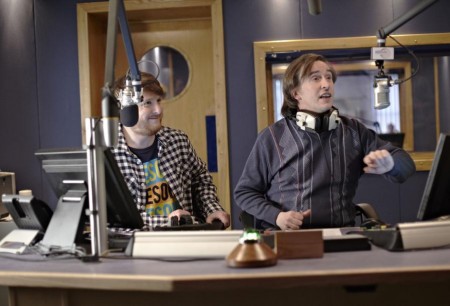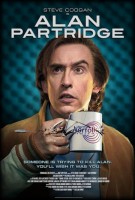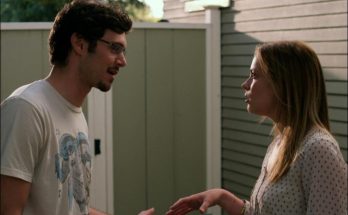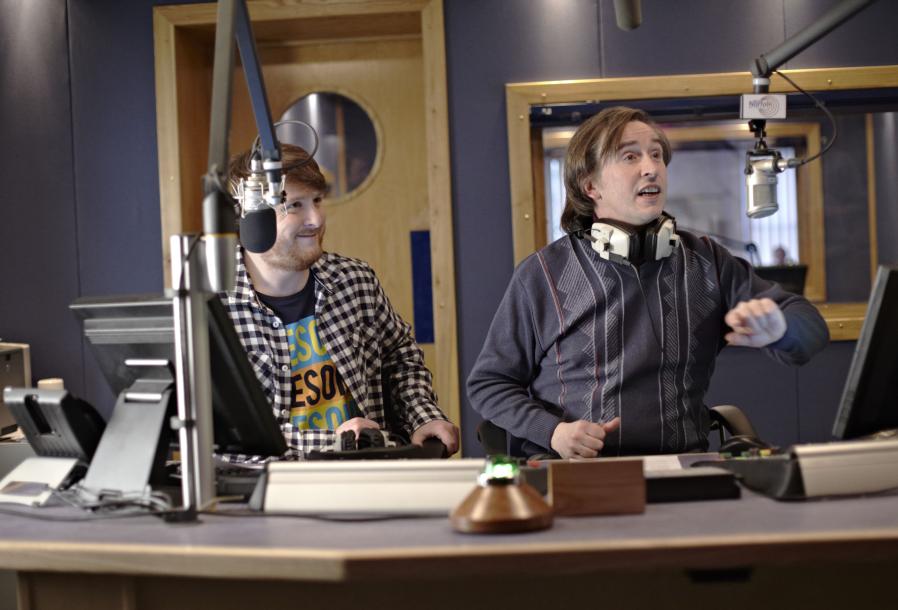Taglines: Someone trying to kill Alan. You’ll wish it was you.
Alan Partridge has had many ups and downs in his life. National television broadcaster. Responsible for killing a guest on live TV. Local radio broadcaster. A nervous breakdown in Dundee. His self-published book, ‘Bouncing Back’, subsequently remaindered and pulped.
The character Alan Partridge first appeared over twenty years ago as a BBC sports reporter on the radio show, On The Hour. Since then, this wonderfully conceited, petty, anal, idiosyncratic comic creation has flourished across virtually every medium you can think of. He’s been a sports reporter (again) on the seminal TV news spoof, The Day Today, host of his own TV chat show, Knowing Me, Knowing You, star of the fly-on-the-wall sitcom I’m Alan Partridge, and most recently Mid-Morning Matters…
About the Film
Alan Gordon Partridge first came to prominence over twenty years ago, as a sports reporter on the BBC’s current affairs radio show, On The Hour. Since then, the wonderfully conceited, petty, anal, idiosyncratic comic creation that is Alan Partridge has flourished across virtually every medium you can think of. He’s been a sports reporter (again) on the seminal TV news spoof, The Day Today, host of his own TV chat show, Knowing Me, Knowing You (which spawned his ‘a-haaaaa!’ catchphrase), and star of the fly-on-the-wall sitcom I’m Alan Partridge, which charted his return to his Norfolk roots at Radio Norwich.
Then, following a sabbatical of several years, Partridge returned in 2010 for Mid-Morning Matters, a webcom that showed Alan in his element as host of the titular radio show. Throw in an autobiography, a pseudo-documentary (Welcome To The Places Of My Life) and an appearance on a faux talk show (Open Books with Martin Bryce), and it seemed that, for Alan, there were no more worlds to conquer. Well, except one: the big screen.
Alan Partridge, at last, brings an enduring comic creation to film, pitching Alan headfirst into a desperate battle for survival that’s both literal and figurative, as he becomes caught up in a siege at his radio station. The decision to transfer Partridge to the silver screen has been a long time coming, but Coogan was adamant that he didn’t want to rush things. “We talked about it a long time ago,” says the actor, who also co-wrote the screenplay and is executive producing through his company, Baby Cow. “But one thing that has governed what we do with Alan is to never do him just because there’s a demand. There has to be a creative impetus.”
That impetus, as it turns out, came from Mid-Morning Matters, which started life as a series of ten-minute webisodes, and introduced key new talent to the Partridgeverse, including Tim Key as Alan’s eager-to-please on-air sidekick, Sidekick Simon, and two new writers, Neil and Rob Gibbons. “We came back with Mid-Morning Matters and, as well as re-examining the character and rebooting it with some fresh blood, if I can mix my metaphors – as Alan might say – the Gibbons provided it. It was a way of road testing Alan, and making sure he was up to scratch. I didn’t need to do a Partridge movie, I wanted to do a Partridge movie. That’s an important distinction.”
Finding Alan
The first port of call for the Partridge movie was finding a format and a story worthy of Alan, and also worthy of the big screen. Initially, Coogan worked on brainstorming ideas with fellow Partridge co-creators Armando Iannucci (who directed both series of I’m Alan Partridge) and Peter Baynham. Many TV shows, from On The Buses to The Inbetweeners, tend to look abroad when they become bigger in scale, and for a while Partridge was going to be no exception. “For a long time we had worked out a story about him maybe being on a ship, and he was going to end up in Dubai, just heading up entertainment on television in Dubai and rising slightly higher than his abilities,” recalls Iannucci.
The core of the story, though, was forged when the idea of placing Alan in the middle of a siege was mooted. At first, the siege was going to be much bigger, with Alan butting heads with terrorists in a manner redolent of Die Hard’s John McClane, but eventually that was scaled back. “I don’t think Die Hard was ever in our minds,” says producer, Kevin Loader. “Dog Day Afternoon was more our inspiration. That has a similarly awkward reality about it, the siege is a bit crap and the hostages are a bit moany, and the siegemakers aren’t very efficient. Here, it’s more of an accidental siege, and some of the comedy comes out of that as well.”
In Alan Partridge, the siegemaker is Pat Farrell (Colm Meaney) who, like Alan, is a DJ at North Norfolk Digital. “He has the late night slot, which is a folksy, chatty, easy listening thing,” says Meaney. “I liken him to the Garrison Keillor of Norfolk. He looks at it like he’s providing a social service as much as entertainment.”
But, with North Norfolk Digital taken over by the predatory Gordale Media and rebranded Shape (motto: ‘the way you want it to be’), Pat finds himself on the wrong end of a P45 and asked to leave. He suddenly snaps and shows up at Shape’s launch party with a vendetta and, more importantly, a shotgun, and so a siege begins. “The feeling is that Pat’s done a really stupid thing here,” says Meaney. “When the cops come he’s a bit like, ‘what are they doing here?’ It spirals out of control.”
For all concerned, it was important to them that Pat pose a real threat (“If the guy with a gun doesn’t feel like he could ever do anything with the gun, there’s no tension,” says Rob Gibbons) and, indeed, he does so throughout the film, covering Sidekick Simon in gaffer tape and improvising a shotgun holster out of a kitchen roll holder that leaves the hapless Simon with a shotgun pointed almost permanently at his head. “It’s pretty undignifying for the character/actor,” laughs Key. “Well, I can’t speak for the character, but I know the actor pretty well, and it’s horrible. There’s a lot of duct tape.”
However, it was also a major point for the Partridge Brain Trust that Pat was a sympathetic character. “The baddie isn’t the man with the gun,” says Coogan. “It’s the big, multinational media organization that only cares about the bottom line, and ultimately lacks humanity. And what Colm did incredibly well was he grounded the film. He helped stop it being childish or fanciful. He was able to marry being a danger and being unstable, and make you feel sorry for him. It’s a very difficult thing to achieve.”
Initially, Alan is not involved in the siege, but as Pat considers Alan to be his only ally at the station, he requests that Alan be brought in as a mediator. There’s just one small problem: Alan was responsible for Pat being fired in the first place, something he’s keen doesn’t come to light…
“The thing with Alan is that he’s the nature of his own undoing,” laughs Iannucci. “We’ve given him the chance to do that in a slightly bigger way.”
That bigger way, though, didn’t extend to the locations. When Dubai, or another similarly exotic locale, was taken off the table, it gave Coogan and his collaborators a chance to root Alan and the action in Norwich, Partridge’s home town. “We wanted Norfolk,” says Coogan. “We wanted the locations to be distinct. Norfolk, even topographically, is a very distinct county. If you see something shot in Norfolk countryside, you only need to see it for a few seconds to recognize it because of the nature of the landscape. They have big skies, almost like African skies. And we wanted to make the location a character in the film. It’s not London, it’s Norwich.”
However, much of the filming was confined to London, as the majority of the film takes place at Shape HQ, for which the production team took over an empty office building in Mitcham and turned it into a fully working radio station, complete with recording booths, reception area, technical areas and green rooms. But when the action eventually moves from Shape to the streets of Norwich, as Pat and Alan embark on a low-speed car chase that ends up at Cromer Pier, Partridge wound up coming home to a rapturous reception. “They find it celebratory and think that I’m one of theirs,” says Coogan of Alan’s homecoming. “That part of England has an otherness, a slight disconnect. You don’t pass through Norwich to get anywhere, and that’s why we chose it for the character. There’s an isolation to the city.”
Writing Alan
When Peter Baynham returned home to America, front-line writing duties on what was then known simply as The Alan Partridge Movie fell to Coogan, Iannucci and the Gibbons brothers. Locking themselves away in a writers’ room, they soon discovered that transplanting Alan to the big screen wasn’t going to be without its challenges.
“It’s that thing of taking a big TV character onto the silver screen,” admits Rob Gibbons. “It has to be true to the movie genre, but also true to the character that people know from TV.”
“A film has to be a story, first and foremost, whereas a sitcom has to be character first and foremost,” adds Neil Gibbons. “We knew it wasn’t a betrayal of the Alan Partridge legacy to impose a bigger story than people would be used to, because that was the only way it would survive as a film.”
And so Alpha Papa, although largely contained to one location, is bigger than any previous iteration of Alan. There’s a car chase (slow), an explosion (small), and gunplay (of sorts), as Alan Partridge becomes an action hero. “Well, I wouldn’t say an action hero,” smiles Coogan. “He’s a coward. But we wanted to take familiar cues and subvert them, or invert them, or reinvent them. Alan would consider himself an all-action guy, but we all know that he isn’t. In his head, he thinks he’s capable of things, but he’s not. People secretly think, what would it be like if I was brave and adept and skillful? It’s an adolescent fantasy.”
Team Partridge were also keen to take advantage of the opportunity afforded by a movie, with its longer running time and three-act structure, and deepen the Partridge character considerably. “We built that into Places Of My Life,” says Neil Gibbons, “because it was an hour long, and you can’t just play comedy comedy comedy all the time. It gets a bit one-note, so you need to look inside the characters. Alan has low points here, and he has to look inwardly at himself, which he’s not traditionally comfortable with.”
Alan’s dilemma in Alan Partridge stems from the guilty knowledge of his involvement in Pat’s sacking, as well as the temptation of the big time, as his participation in the siege makes him something of a headline figure once more. “There’s a story just below the surface of the movie where Alan gets to make a moral choice, which isn’t always the case for him,” says Kevin Loader. “The plot involves a Darwinian businessman, and Alan has the opportunity to throw his hand in with the wealth-creating bastard class. He’s offered that choice very clearly at a key moment of the film: one of the things Steve was keen to do was to make sure the film has emotional heft as well as great gags.”
As Alan Partridge begins, in fact, Alan is happier than he’s been for quite a while. He’s driving a brand new car from a well-known sponsor, he’s come through a Toblerone-fuelled midlife crisis and out the other side relatively unscathed. “He’s a DJ, he’s in Norwich, he’s in his mid-50s, everything is alright,” says Coogan. “We want people to think that Alan’s minding his own business and getting on with it. The hair’s a bit longer, he’s starting to think of himself as a little bit hipper. There’s a certain woman he may still be able to charm. He hasn’t thrown in the towel by any means.”
This iteration of Partridge, while still being recognizably Alan, is perhaps the most well-rounded version of the character that Coogan has played in his association with the character. “We’ve constructed it to show Alan being bullish, big-headed, egotistical, but also, at heart, being flawed but decent. You want people to like him and care about him, or you can’t sustain a film.”
With another series of Mid-Morning Matters due to come after Alan Partridge, it’s clear that Coogan still has enormous affection for Partridge; that the well is far from dry. “In some ways, it’s the easiest acting job I do, because I’ve spent 20 years researching the character,” he says. “When I go into doing Alan it’s like putting on an old jacket. It’s very comfortable for me. I still think he’s funny. When I watch takes back and watch myself as Alan, I laugh, but I don’t feel I’m laughing at myself, I’m laughing at a character… that I happen to perform!”
Coogan admits to having the final veto in the scripting process (“I can say no to anything because they can’t make someone physically say something!” he laughs), but the writing process on Alpha Papa is a very democratic one. Over the last few years, the Gibbons, especially, have become known as the arbiters of Alan, the keepers of the Partridge flame. “It’s not something you can teach,” says Iannucci. “Steve and I have been doing Alan for about 20 years. But the thing with Neil and Rob is that they get it. They can just slip into Alan with ease. You find with other writers who try Alan that they do a parody of Alan and his various traits are exaggerated, but Neil and Rob pitch it just right and they’re very good at keeping it real and not pitching him into too absurd a situation.”
Speaking of absurd situations, it transpires that when Team Partridge are writing together, the brothers Gibbons and Iannucci quite often end up saying prospective Alan lines in the voice of Alan… with the man who is Alan sitting just feet away. “I can’t commit to it because Steve’s sat there,” he says. “You can’t do an impression of someone who does the voice himself. Armando really commits to it, though.” Iannucci, whose Partridge has more than a tinge of a Scottish brogue, laughs. “You have to go into Alan mode, and then it splurges out. But it’s not like we’re auditioning to permanently replace Steve,” he says. “Steve is the best at it.”
The writing staff were rounded out by Graham Duff, who provided some useful script editing notes throughout the production, helping Steve and the Gibbons keep track of the narrative arc whilst they finessed dialogue and the finer points of the script.
Alan Partridge
Directed by: Declan Lowney
Starring: Steve Coogan, Colm Meaney, Sean Pertwee, Anna Maxwell Martin, Jessica Knappet
Screenplay by: Peter Baynham, Steve Coogan, Neil Gibbons, Rob Gibbons
Production Design by: Dick Lunn
Cinematography by: Ben Smithard
Film Editing by: Mark Everson
Costume Design by: Julian Day
Set Decoration by: Anna Kasabova
Art Direction by: Andrea Matheson
Music by: Ilan Eshkeri
MPAA Rating: R for language, brief violence and nudity.
Studio: Magnolia Pictures
Release Date: April 4, 2014
Visits: 170








